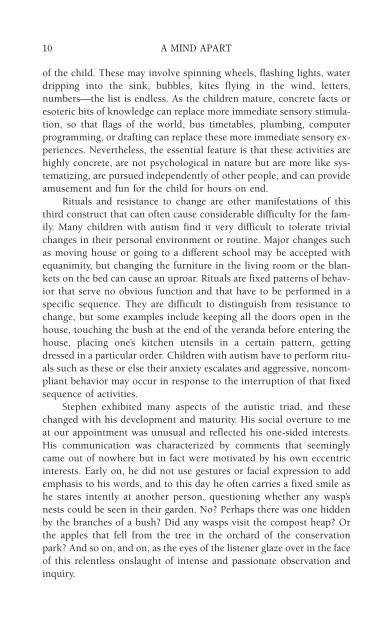978-1572305441
autism
autism
You also want an ePaper? Increase the reach of your titles
YUMPU automatically turns print PDFs into web optimized ePapers that Google loves.
10 A MIND APART<br />
of the child. These may involve spinning wheels, flashing lights, water<br />
dripping into the sink, bubbles, kites flying in the wind, letters,<br />
numbers—the list is endless. As the children mature, concrete facts or<br />
esoteric bits of knowledge can replace more immediate sensory stimulation,<br />
so that flags of the world, bus timetables, plumbing, computer<br />
programming, or drafting can replace these more immediate sensory experiences.<br />
Nevertheless, the essential feature is that these activities are<br />
highly concrete, are not psychological in nature but are more like systematizing,<br />
are pursued independently of other people, and can provide<br />
amusement and fun for the child for hours on end.<br />
Rituals and resistance to change are other manifestations of this<br />
third construct that can often cause considerable difficulty for the family.<br />
Many children with autism find it very difficult to tolerate trivial<br />
changes in their personal environment or routine. Major changes such<br />
as moving house or going to a different school may be accepted with<br />
equanimity, but changing the furniture in the living room or the blankets<br />
on the bed can cause an uproar. Rituals are fixed patterns of behavior<br />
that serve no obvious function and that have to be performed in a<br />
specific sequence. They are difficult to distinguish from resistance to<br />
change, but some examples include keeping all the doors open in the<br />
house, touching the bush at the end of the veranda before entering the<br />
house, placing one’s kitchen utensils in a certain pattern, getting<br />
dressed in a particular order. Children with autism have to perform rituals<br />
such as these or else their anxiety escalates and aggressive, noncompliant<br />
behavior may occur in response to the interruption of that fixed<br />
sequence of activities.<br />
Stephen exhibited many aspects of the autistic triad, and these<br />
changed with his development and maturity. His social overture to me<br />
at our appointment was unusual and reflected his one-sided interests.<br />
His communication was characterized by comments that seemingly<br />
came out of nowhere but in fact were motivated by his own eccentric<br />
interests. Early on, he did not use gestures or facial expression to add<br />
emphasis to his words, and to this day he often carries a fixed smile as<br />
he stares intently at another person, questioning whether any wasp’s<br />
nests could be seen in their garden. No? Perhaps there was one hidden<br />
by the branches of a bush? Did any wasps visit the compost heap? Or<br />
the apples that fell from the tree in the orchard of the conservation<br />
park? And so on, and on, as the eyes of the listener glaze over in the face<br />
of this relentless onslaught of intense and passionate observation and<br />
inquiry.



